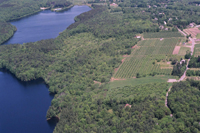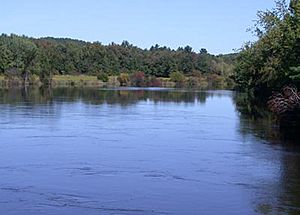Nashaway facts for kids
The Nashaway (also called Nashua or Weshacum) were a group of Algonquian Native Americans. They lived in the valley of the Nashua River in what is now central Massachusetts. This area included towns like Sterling and Lancaster. It was also near Mount Wachusett. The name Nashaway means "river with a pebbled bottom."
The main village of the Nashaway was called Waushacum. This name might mean "surface of the sea." Waushacum was in what is now Sterling, Massachusetts. It was located between two ponds that had the same name.
Contents
Nashaway Lands and Neighbors
The Nashaway people lived in a specific area. To the north, along the Nashua River, were the Pennacook tribe. The Nashaway often formed alliances with this powerful group. To the east, they bordered tribes related to the Massachusett people. South of their main river sources were different groups of the Nipmuc tribe. To the west, near the Connecticut River, lived the Pocomtuc people.

Early reports about the Native American groups in Massachusetts were not very detailed. Each smaller Nashaway group had its own leader, called a sachem. They usually acted on their own. These groups spoke a similar language and shared customs. However, there isn't much proof they formed a large alliance. This changed when they faced conflicts with English colonists. These conflicts eventually led to a major event called King Philip's War. The Nashaway often made alliances, especially with the Pennacook.
Leaders and Challenges
The Nashaway lived far from the main English settlements. This made it hard for missionaries like John Eliot to visit them. When the first minister, John Prescott, came to the tribe, a new leader was in charge. This leader was Nanomocomuck, also known as Monoco. He was a Pennacook chief and a descendant of Passaconaway.
Records show that Chief Monoco faced problems with debts. These debts were for goods bought from the colonists on credit. The prices for these goods were often very high. This situation led to the Nashaway losing some of their land. These tensions helped cause King Philip's War. In 1674, Daniel Gookin, who oversaw "Praying Indians," sent Peter Jethro to help. Peter Jethro was an "Indian missionary minister." He worked with the Nashaway in areas like Lancaster and Sterling.
The Fate of the Nashaway
The exact fate of the Nashaway tribe is not fully known. Many of the remaining Nashaway people left their homeland. They joined other tribes, such as the Pennacook or the Nipmuc. They often married into these new communities.
Sadly, the Nashaway tribe is now considered extinct. However, their descendants still live among other Native American groups today. Many Nashaway people died when they were forced to live on Deer Island in Boston Harbor. Their descendants can be found among the Abenaki people in New England and Canada. Some also live among the Schaghticoke tribe.
Legacy of the Nashaway
The Nashaway people left their mark on the land. Many places are still named after them. For example, the Sholan area in Leominster is named after Chief Nashawhonan (Sholan). The city of Nashua and the Nashua River are also named after the tribe. Even Mount Wachusett carries their history.
During King Philip's War, the Nashaway sachem (chief) Monoco captured a woman from Lancaster named Mary Rowlandson. She later wrote a very popular book about her experience. Her story described her forced journey and her eventual release. This type of book was called a captivity narrative. These stories often talked about a person's spiritual journey during their captivity.


